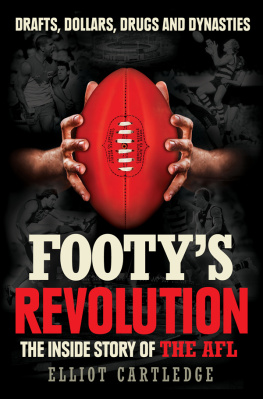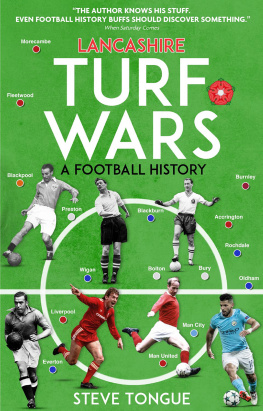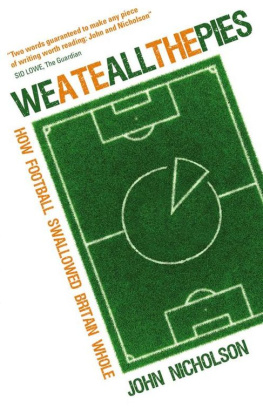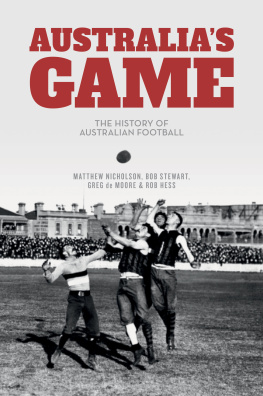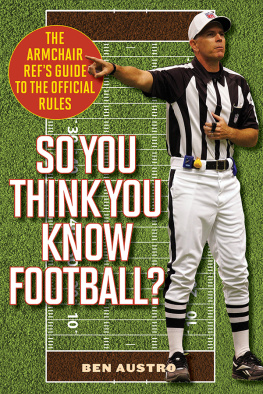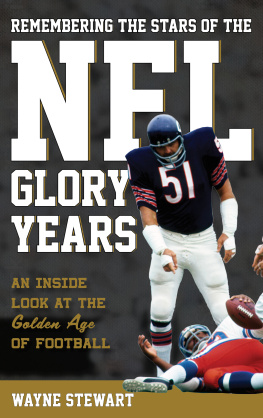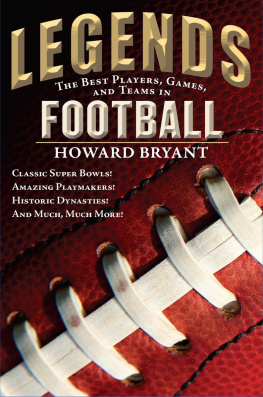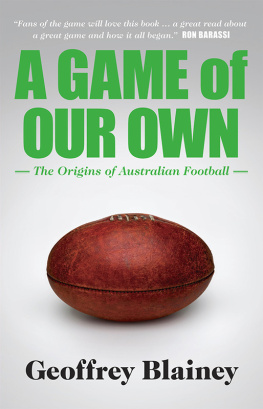
CONTENTS
For the purposes of historical accuracy and clarity, venues are referred to by traditional or geographical titles only. Naming rights to stadiums seem to change hands every other year so, accordingly, Subiaco, Docklands, Football Park, Kardinia Park, Carrara, et al., take precedence. As far as club names are concerned, each is organised according to chronology. So Footscray precedes the Western Bulldogs, Brisbane is referred to as the Brisbane Bears until the merger with Fitzroy, and for the sake of convenience North Melbournes eight-year flirtation with a single moniker Kangaroos is ignored.
As many readers will appreciate, the Victorian Football League (VFL) continued operating under that name even after the introduction of non-Victorian teams. It became the Australian Football League (AFL) at the beginning of 1990. Similarly, the Victorian Football Association (18771995), forerunner to todays VFL, is referred to as the VFA where chronologically appropriate. The domestic competitions in Western Australia and South Australia continue to operate under their traditional names, the West Australian Football League (WAFL) and South Australian National Football League (SANFL) respectively. The Queensland Australian Football League (QAFL) was subsumed in 2010 by the North Eastern Australian Football League (NEAFL) but recommenced as a league in 2014.
As far as media organisations are concerned, I have tried to simplify the multiple changes in titles, ownership and format. Where appropriate, I have maintained usage of the titles referred to in contemporary accounts of the era and do not, unless of particular note, separate print and electronic media titles from their online counterparts.
In terms of my sources, I conducted interviews with players, coaches, administrators and media between September 2017 and February 2018. Material examined includes club and competition histories, annual reports, media briefings, consultancy findings, newspaper and online articles, books, academic studies, aural sources, documentaries, court proceedings and financial reports. Authors of original works have been cited wherever possible and quotes made during interviews or press conferences have been treated as in the public domain, with citations where appropriate.
Every effort has been made to trace and acknowledge copyright. The publisher welcomes any information from people who believe their images or words have been used without due credit. Some photos have been retouched to remove imperfections but otherwise they are true to the original.
Given the quantity of results, statistics, events, anecdotes, quotes, dates, references and names contained in the following pages I ask the readers understanding should any factual or typographical incorrectness arise. Any errors are solely my responsibility.
Finally, lest it be imagined the AFL was not afforded the opportunity to respond to the contentions that follow, a number of invitations were issued in line with requested protocols. Readers can draw their own conclusions.
Melbourne Cricket Ground, 16 April 1996
The AFLs centenary ball is a night to remember in more ways than one. Beneath a gargantuan marquee, singer John Farnham and other acts entertain around 3200 guests, some of whom have paid $500 to attend. Everything is on a grand scale; the dance floor alone is the equivalent size of three tennis courts. Crates of Mot are consumed along with 400 punnets of strawberries, half a tonne of Atlantic salmon, truckloads of beef and chicken and 170 kilograms of chocolate. At one point during the gala evening, club theme songs given synthesised treatments are accompanied onstage by an assortment of past and present AFL players miming and moving around. A particular oddity is a Mike Bradyled chorus of choreographed schoolchildren boot scootin to a country musicflavoured version of the Fremantle Dockers theme. Odder still is the hip-hop rendition of Were from Tigerland.
In its centenary season, the AFL was primed to celebrate. The worst of footys recession felt like it was in the past. Revenues were four times those of the mid-1980s, and average attendances were up 40 per cent and growing. Broadcast rights were predicted to double in value and corporate sponsorship was flying high. Pleasingly for the proponents of a truly national competition, the latest non-Victorian club to enter the AFL, Fremantle, had performed creditably in its debut season in 1995. After no end of teething problems, all of the other new clubs were holding their own or on the rise. One of them the West Coast Eagles was already a dual premier after less than a decade in the AFL.
There was more good news. Tony Lockett had crossed from the Saints to Sydney, booted 110 goals, and AFL was back on the radar in the harbour city. In Melbourne, three of the big four clubs Carlton, Essendon and Richmond had outstanding seasons in 1995 and MCG crowds surged. Gary Ablett Sr, a one-man highlights package, had again topped the ton. He, along with Lockett and Hawks power forward Jason Dunstall, formed a goal-kicking triumvirate unrivalled in the games history. Coverage was expanding, too, with the traditional Sunday morning panel shows now joined by Talking Footy for deeper analysis of the games issues and The Footy Show, an extremely successful hybrid of footy news and light entertainment built around the announcement of league teams.
In addition to the AFLs celebratory spending, the competition was in its third year of a massive promotional makeover. Stung by the success of the National Rugby Leagues Simply the Best campaign, AFL executives drafted advertising gurus to retaliate. The budget for the initial run of Id like to see that promos featuring Carl Lewis and John McEnroe was relatively modest at less than half a million dollars. But in the centenary season, the purse strings were let loose as Desmond Tutu, John Lee Hooker and, famously, a soon-to-expire George Burns, were booked for cameos. The budget even extended to building a film set for actress Heather Locklears seven-second appearance.
Yet shades of light and dark were ever present. In the lead up to the ball, an estimated 500 workers had erected the 7500 square-metre marquee, which ended up covering almost three-quarters of the MCGs playing area. Much to the displeasure of the Melbourne Cricket Club, responsible for the grounds management and development, 2000 holes sunk in the damp surface to support the marquee caused enough damage for the venues next two fixtures Footscray versus Hawthorn and Richmond versus Sydney to be moved. The Tigers had the biggest cause for complaint. They went down by a solitary point to the Swans at the neutral but waterlogged Waverley Park and missed out on the 1996 finals as a result. The salt in the wound was a percentage almost 20 per cent higher than eighth-placed finisher Hawthorn. That said, the Hawks were held to a draw by the lowly Doggies at a similarly saturated Western Oval in their relocated match.
At the same time, clubs and directors were openly squabbling among themselves and with league headquarters about the makeup of the competition, its venues, its fixture and how players should be remunerated. After just three rounds of the centenary season, a total of nine players had wrecked their knees and required reconstructions, among them Adelaides gifted ruckman Shaun Rehn and West Coasts inspirational skipper John Worsfold. The AFLs melee rule was in the headlines as no less than ten players from the Crows and the Cats fronted the tribunal and copped $35,000 in fines following a spiteful clash at Football Park. Seven weeks later, high-voltage equipment at Waverley Park failed during the Saturday night game between Essendon and St Kilda just before three-quarter time. In the inky gloom the match was abandoned triggering mindless vandalism and spot fires from angry spectators. The clubs returned to the venue three nights later to play out the contest.
Next page
